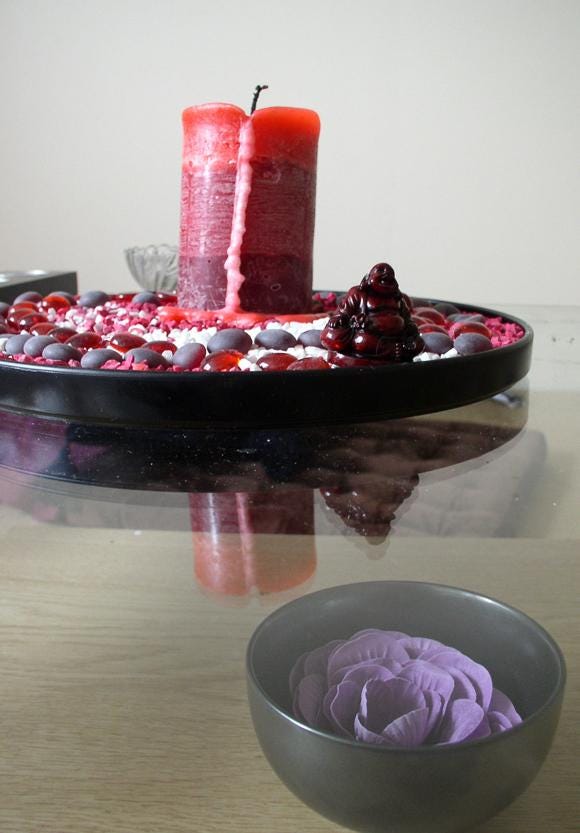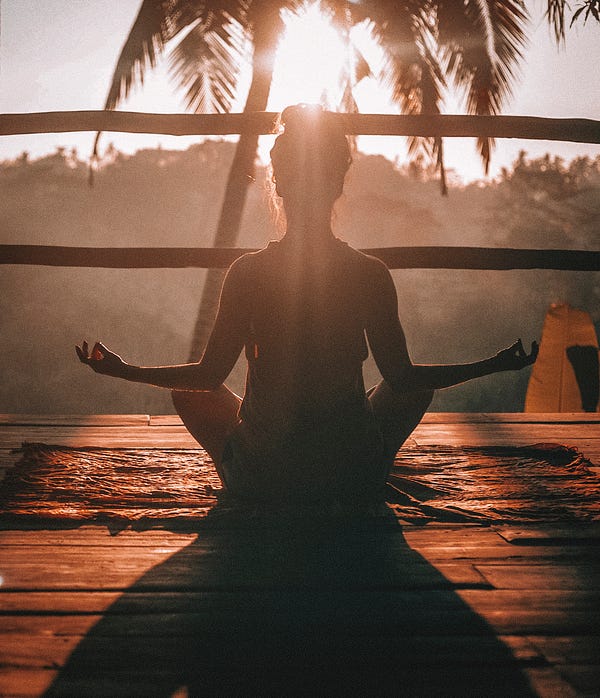Progress can sometimes feel like suffering when you’re in the middle of it

If people ask me how much I meditate, I’ll be coy about it — as if it’s a secret, personal experience shared between the universe and me. Too many people are carrying trauma as we endure the ravages of a pandemic, so I feel it’s important to share some of the lessons I’ve collected during my decades-long, practice of meditation with PTSD.
I can attest that meditation can help with trauma — I can also attest that the wrong approach can hurt.
Medical Disclaimer: I’m not a medical professional and of COURSE I think you should seek professional help if you are able. If you are seeking therapy, especially about trauma, please discuss meditation practices with your therapist. Please, be aware that any tool that is powerful enough to help you to heal can also be harmful. Be cognizant and cautious when embarking on a new path.
If one type of meditation feels like it’s harmful or you’re certain it’s not for you, you can try others.
People have a tendency to talk about meditation as if their form of meditation is the only one, and that it is good for every situation in their lives. When a new practitioner tries that method and it doesn’t work for them or ‘feel right’ — that can be discouraging! Maybe Buddha gained enlightenment by sitting still under a bodhi tree, but were you born a prince? Be open to the fact that doing what someone else did might not be your path.
When I first tried to meditate, I was convinced by someone that meditation meant sitting absolutely still and thinking about NOTHING. I was miserable doing it, I was terrible at it, and I never really got better because I hated meditating that way. Luckily, I wasn’t discouraged for long and continued to seek other ways to meditate.
It is valid to listen to what your mind (and body) tell you during your meditation sessions (it is also valid to let it go and sit as still as humanly possible if that’s your meditation practice). The difference for me as someone who sits with trauma is that if I find myself having an extreme reaction (rage, fear, anxiety), I prioritize giving that emotion space over arbitrary rules dictating what I’m doing.
It was by allowing myself to understand this was a practice of self-care and self-compassion that I was able to allow meditation to become less rigid. Paradoxically, I became more disciplined.
If you find yourself having adverse reactions to silence, try a guided meditation!
Do you struggle to sit still while meditating and hate it? Lay down. I do! Or, try walking meditation!
Do you find your mind wandering far too much to control it? Try mantra meditation!
Do you crave the utter discipline of zazen? Then do it!
Does mindfulness bring trauma to the surface or make you feel awful? Try a breathing meditation! Are you preparing for a huge goal? Use some meditation time to visualize what it will be like when you achieve it.
Feel free to change your meditation techniques to deepen your practice, and discover your favorites! You’ll discover a variety of meditation techniques with a large array of uses.
Meditation is not a panacea that will solve all of life’s problems.

Meditation hasn’t solved all of my problems for me, that’s for sure. But meditation has helped me recognize times when I am being a problem. It is one of my go-to tools, and it’s become a meaningful part of my life.
It took a long time for me to understand what types of meditation would help me to work with some of the issues I was facing — and I even found that some meditation techniques made things worse. There have been times that my ‘inability to meditate in the right way’ made me feel more broken as a person, or even put me into situations where I was retraumatizing myself because I was insistent it was the cure that I needed. I’m not alone — there have been many studies across several meditation disciplines that demonstrate that meditation can sometimes increase anxiety and depression.
Because of my PTSD, I found that mindfulness could feel perilous. When I would try to mindfully focus on my breath and sensations in my body, it would trigger memories or powerful waves of emotion that I wasn’t able to handle. If I was in any sort of pain I risked spending the entire session falling into that pain.
More than once during a particularly intense period of working with different types of pranayama, a breath-based meditation, I collided with emotions so intense I had to pause in order to have a good cry while processing them. While meditation didn’t cure the trauma I was experiencing, it helped me to understand and recognize that while I was processing these large emotions — at that moment I was safe to do so.
Meditation itself isn’t a cure — it’s a powerful tool of self-discovery, and that can lead to healing.
Relationships with meditation might be filled with oddities and challenges.
This can manifest itself in many different ways — from how long you sit to what you do while you’re sitting.
David Lynch swears by his regular practice of 2 20 minute sessions of full-on bliss a day, and who the hell am I to argue with that? My personal experience is different — sometimes one formal 20-minute session is so far from bliss it leaves me so exhausted and frustrated with myself that my consciousness rebels at the thought of a second session.
When I encountered the Dark Night of the Soul, I was so profoundly shaken by the feeling that even meditation had abandoned me, too that I had to take a few weeks off before even trying a tentative practice again. It has been years since that experience, and while I have learned many lessons from that experience and embrace it as a particularly dark and harrowing part of the journey — I am still wary about re-traumatizing myself in that way.
That’s when I remind myself that meditation is my practice — it’s all in my head. It’s okay if my relationship with it is different and odd — I am different and odd.

Recognize when you’re in your own way.
I know my enemy quite well, and when it comes to meditation — that enemy is, of course, me. For a while, before I engaged in some focused, self-compassion meditation, I found it hard to ‘make time to sit.’
After taking some time and examining what was happening, I discovered the common ways I’d disrupt myself. I would insist that my space ‘wasn’t good’ for meditation and that I’d have to wait until I could make it better.
Or I’d convince myself that the time wasn’t perfect because I was waiting on something. Or, I’d launch into ‘serious self-inquiry,’ asking myself whether I was REALLY meditating if there’s a bunch of noise, I’m expecting an email I need to respond to, and I wasn’t seated just so in front of that perfect altar in that peaceful space?
YES.
There are times when my meditation needs a boost when I will go all out, build a quick, impromptu altar, and relish that experience. It is a definite treat experience — but after some practice, I’m also just as capable of meditating to the noises of traffic.
People, even the wisest of gurus, often want their way to be the way that helps you because humans love to solve problems, and that’s true for meditation, too. Sometimes, those people are wrong.
Mindfulness meditation was a great teacher of this lesson for me. I struggled with mindfulness meditation, finding it particularly difficult for me to reconcile with my PTSD. My sessions would often leave me spiraling. That surprises people, especially its ardent practitioners. The fact I had this sort of reaction and difficulty helped teach me that sometimes when passionate people think something will help — they’ll oversell it a little (or, you know, a lot).
This includes me!
Maybe it is as simple for you as using an app. Maybe Vipassana is as amazing as they say and I’m just broken or not disciplined enough.
I can’t say what works for someone else — but I can say for certain I have noticed the ‘law of the instrument’(to a person with a hammer everything’s a nail) holds true in the meditation space.
It is the practice itself, and not its perceived results that matter.
It really is that simple.
But to put a finer point on it — it’s often very hard to see our meditative progress. This is especially true after challenging sessions that bring up trauma that needs to be processed, or exhausting sessions that don’t offer the bliss we were seeking. Because meditation is all in our mind, it’s easy to lose sight of the progress made by sitting at all. Progress can sometimes feel like suffering when you’re in the middle of it.
When feelings of frustration overwhelm my ability to see my own progress, reminding myself that it’s the practice itself that is important helps me to relax into the process more.
I hope that these lessons help those looking to add meditation to their lives or deepen a practice that’s already present.
Take care of yourselves!
Sources , Other Experiences, and Reads I Enjoyed:
Can mindfulness be too much of a good thing? The value of a middle way Willoughby B Britton.
Lost in Thought: The Psychological Risks of Meditation by David Kortava.
Buddhist Meditation and the Dark Night of the Soul on learnreligions.com
First, do no harm: An intensive experience sampling study of adverse effects to mindfulness training by AnnaAizik-Reebs Adi Shoham Amit Bernstein
By Jamie Toth, The Somewhat Cyclops on .
Exported from Medium on December 5, 2021.